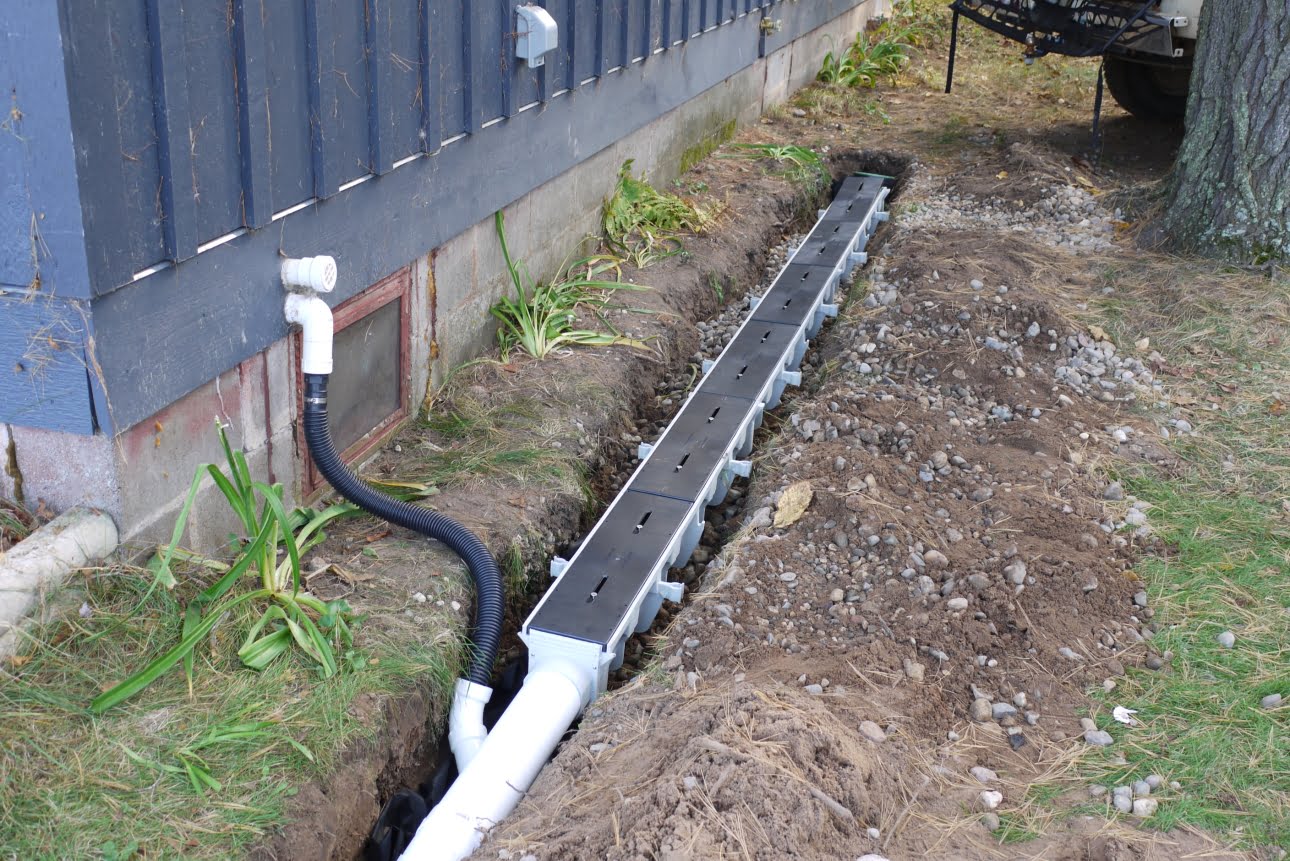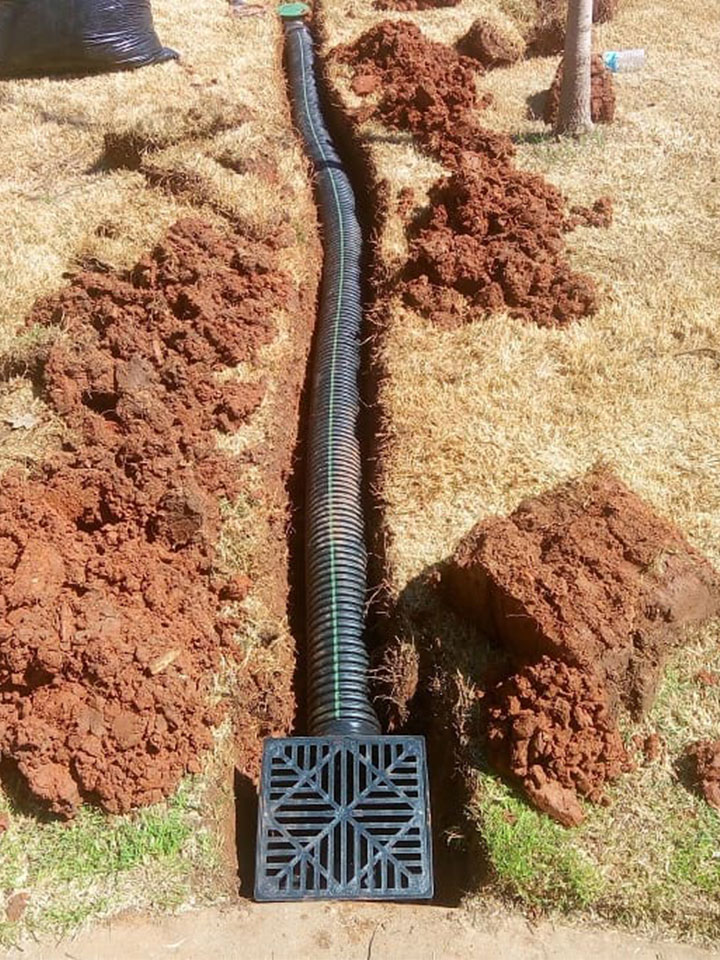Ways a French Drain in Ft Worth Can Stop Basement Flooding
Wiki Article
Expert Solutions for Your French Drain Requirements and Installation
When it comes to handling water drainage on your property, a French drainpipe can be a video game changer. It's not simply about excavating a trench; it's concerning guaranteeing efficient water management customized to your details needs.Understanding French Drainpipes: What They Are and How They Work
A French drain is an easy yet reliable solution for managing excess water in your yard. It's designed to reroute water away from locations susceptible to flooding or pooling. Essentially, it contains a trench loaded with crushed rock or rock, including a perforated pipeline near the bottom. When it rains, water permeates into the trench, where the pipeline accumulates it and networks it far from your property.
This system functions by using gravity to overview water towards a designated water drainage area, like a storm drainpipe or dry well. By developing a path for excess water, a French drain helps protect against soil erosion, shield your foundation, and maintain the health of your landscaping.
Installing one can greatly improve your lawn's drainage and lower the risk of water damage. With proper understanding of its function, you can make an informed decision regarding whether a French drain is right for your scenario.
Key Aspects to Consider Before Installation
Prior to diving right into the setup of a French drain, it's essential to assess several essential variables that could affect its efficiency. Next, consider the soil kind; sandy dirts drain better, while clay retains water, affecting the total efficiency of the system.You need to additionally check regional laws and codes to guarantee your installment abides by any kind of legal needs. Furthermore, think of the slope of your backyard. A correct slope is basic for routing water circulation toward the drainpipe. Finally, evaluate your spending plan and whether you can take on the installation on your own or require specialist assistance. By attending to these elements at an early stage, you'll establish the phase for an effective French drain setup that properly handles water overflow and secures your building.
Step-by-Step Overview to Mounting a French Drainpipe
Since you recognize the essential variables, let's delve into the step-by-step guide for installing your French drain. You'll need a couple of important devices and materials ready to make the process smoother. We'll go through the setup procedure so you can tackle this project with confidence.Required Devices and Products
Mounting a French drain requires specific devices and products to guarantee an effective result. Initially, you'll require a shovel or trenching tool to dig the drainpipe line. A degree is vital for ensuring correct slope, while a tape action assists you figure out the correct range. You'll also want perforated drain pipeline to allow water to move via. Gravel or smashed stone works as a filter, stopping obstructing. Don't forget a landscape material to keep dirt out of the gravel. Furthermore, a wheelbarrow makes carrying materials easier. Finally, safety gear like gloves and safety glasses is crucial to secure yourself throughout the installation. Collecting these devices and materials in advance will certainly simplify your project and establish you up for success.Installment Process Introduction
Once you've collected your products and devices, it's time to dive right into the installation process of your French drain. Note the area where you'll dig, making certain a small slope for appropriate water drainage. Next off, use a shovel to excavate a trench regarding 6 inches broad and 18 to 24 inches deep. Lay landscape material in the trench, enabling additional fabric to cross the top. After that, add a layer of gravel, regarding 3 inches deep, prior to placing the perforated pipeline with the holes facing down. Cover the pipeline with even more gravel, filling the trench to around 2 inches listed below ground level. Fold up the landscape textile over the crushed rock, and fill the continuing to be room with soil. Your French drainpipe is currently all set!Typical Materials Made Use Of in French Drain Systems
When planning your French drainpipe system, it's vital to select the ideal products. You'll wish to consider numerous crushed rock kinds and dimensions, along with the choices for pipeline products. Don't ignore material and geotextiles, which play a crucial role in avoiding debris build-up.Crushed Rock Kinds and Sizes
Selecting the best gravel type and dimension is important for an effective French drainpipe system. You'll wish to use clean, angular crushed rock, as it permits much better drain and stops obstructing. Ft Worth French Drain Installation. Commonly, a mix of 3/4-inch and 1-inch gravel works best, giving adequate area for water to move while still providing stabilityAvoid making use of spherical crushed rock, as it can move and develop voids that catch water. Think about larger gravel sizes to enhance water drainage efficiency if your area has a great deal of silt or clay. You can additionally top it off with a layer of smaller sized gravel to assure suitable purification. Keep in mind, the right crushed rock choice can considerably affect your drain's longevity and capability.
Pipe Product Options
Several pipe products are commonly used in French drainpipe systems, each offering distinct benefits. PVC pipes are a prominent option as a result of their resilience and resistance to rust. They're simple and lightweight to set up, making your drainage project a lot more manageable. Corrugated plastic pipelines are flexible and allow for easy bending around obstacles, although they may be much less resilient over time. If you're trying to find stamina, consider making use of perforated concrete pipes; they provide outstanding water circulation however can be heavy and extra tough to mount. Lastly, steel pipelines, such as galvanized steel, offer durability and strength but can be vulnerable to rust. Consider your specific requirements and budget when selecting the ideal material for your French drainpipe system.Material and Geotextiles
Material and geotextiles play an essential role in the effectiveness of French drainpipe systems. These materials act as a barrier, preventing dirt and sediment from clogging your water drainage pipelines while enabling water to flow openly.Mounting the textile correctly is imperative; it should cover around the gravel and pipeline, creating a safety layer. Make sure to overlap seams to stay clear of spaces. Using premium geotextiles can significantly expand the life of your French here are the findings drainpipe, reducing upkeep issues down the line. So, invest in great textile, and you'll improve your system's efficiency.
Maintenance Tips for Long-Lasting Efficiency
While setting up a French drainpipe is an essential step why not find out more in managing water drain, normal maintenance guarantees it continues to carry out efficiently over time. Clear away leaves, dirt, or any kind of obstructions that might hinder water flow.Think about flushing your drainpipe with water every few months to displace any minor blockages. If you see pooling water or slow-moving drain, it could be time to dig much deeper right into possible issues. Constant focus will help your French drain last much longer and function efficiently.
Fixing Usual French Drain Problems
Also with normal upkeep, issues can occasionally develop with your French drainpipe system. One common issue is clogging, which may take place as a result of sediment buildup or debris. To resolve this, you can purge the drain with a hose pipe or make use of a plumber's snake to remove the blockage.An additional issue is inappropriate drainage, which may arise from incorrect incline or installation. To fix this, examine the incline of your drainpipe and adjust it as needed to assure water flows far from your structure.

If you experience consistent smells, it might be due to stagnant water. Examine for leakages or clogs causing the problem. On a regular basis evaluating and addressing these concerns can maintain your French drainpipe system working properly, safeguarding your home from water damages.
When to Call in the Professionals: Indications You Need Aid
How can you tell when it's time to call in the experts for your French drainpipe system? When your drainpipe's not successfully channeling water, it can lead to significant problems like foundation damage or mold and mildew growth.
If you have actually tried Do it yourself solutions without success,You must likewise reach out for assistance. If you're unclear about the drainpipe's format or the degree get more of the trouble, consulting a specialist can conserve you time and money. Finally, if your system is clogged, outdated, or damaged, specialist intervention is essential. Trust fund your impulses; if it really feels frustrating, it's ideal to get skilled help to assure your French drain works efficiently.
Often Asked Questions
How Deep Should a French Drain Be Mounted?
You must install a French drainpipe at the very least 6 inches deep, yet ideally, objective for around 12 to 18 inches. This depth assists effectively redirect water away from your foundation and avoids flooding.Can I Set Up a French Drain Myself?
Yes, you can set up a French drain yourself. It requires some preparation, excavating, and correct products, but with the right tools and assistance, you'll manage to produce a reliable drain system for your residential property.What Is the Price of French Drain Setup?
The cost of setting up a French drainpipe typically ranges from $1,000 to $7,000, depending upon factors like length, deepness, and labor. You must get several quotes to locate the most effective offer for your project.How Long Does a French Drain Last?
A French drainpipe generally lasts around 30 to 40 years with proper maintenance. You'll intend to consistently look for blockages and guarantee the water drainage system operates effectively to optimize its life-span and protect against expensive repairs.Do French Drains Call For a License for Installation?
You may need a license for installing a French drain, depending upon local guidelines. It's best to talk to your municipality or homeowner's association prior to beginning any job to stay clear of potential fines or problems.Conclusion
To summarize, investing in a specialist solution for your French drain requires guarantees reliable water administration and secures your property from potential damages. By understanding the setup procedure, selecting the best products, and dedicating to routine upkeep, you can take pleasure in a durable water drainage system.When it comes to managing water drainage on your building, a French drainpipe can be a game changer. By addressing these variables early on, you'll establish the stage for a successful French drain installation that effectively manages water runoff and shields your residential or commercial property.
While setting up a French drain is a crucial step in taking care of water drain, normal upkeep guarantees it proceeds to execute effectively over time. Frequently checking and attending to these worries can maintain your French drain system operating effectively, securing your residential or commercial property from water damages.
To summarize, investing in a professional remedy for your French drainpipe requires warranties effective water monitoring and secures your building from potential damages. Ft Worth French Drain Installation.
Report this wiki page